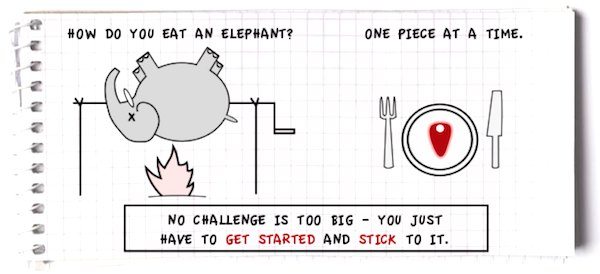Success Advice
Success….And What It Really Takes To Achieve It
So what does it really take to reach success? There are a lot of myths, the “he says”, “she says” out there but does anybody really have the answer? Success is subjective and has a different definition for each individual.
So let’s take a look through the ages at what is considered as “success”, and what is needed to reach a level of high achievement in various areas of our lives.
Geniuses Aren’t Born….. They’re Made
Books like The Da Vinci Curse by Leonardo Lospennato does a good job of summing up a problem of our time: that anyone striving to be a universal genius will inevitably fail. Because today, unlike in Da Vinci’s time, there’s so much competition out there in every field that only people who devote themselves to one subject are successful. Anyone who wants to be a professional high flyer, the “Father of the Year,” a star violinist, a globetrotter and an art connoisseur all at once should either rethink his priorities or feel satisfied about being incredibly mediocre in each of these fields. After all, it’s rare for a genius to be an all-rounder.
The secret trick: lots of practice and even more mistakes.
Alleged geniuses like Mozart, Goethe and Picasso are not famous the world over for their unique inborn gifts: they were simply lucky enough to be born with a certain amount of talent that they could then cultivate with a whole lot of hard work and dedication.
Anyone who wants to emulate a genius should take note of the fact that neither Mozart nor Einstein changed his profession every couple of years. One reason why Steve Jobs was so successful was that he put all his energy into one thing – and in the process sacrificed his chance of ever winning the “Father of the Year” award. It’s not to say that this path doesn’t have potholes, traffic and detours, but instead that only people who experiment without fear of failure and accept that they can learn from it are bound to produce great things.
Napoleon and the light bulb: getting rich by thinking?
Over 100 years ago, Napoleon Hill asked himself whether the success of outstanding personalities could be explained by a formula. Did they all use the same toothpaste? Did they all follow the same traveling priest? Hill’s answer, which he used as the basis for his book Think and Grow Rich, was far more rudimentary: for him, success and wealth were the consequence of having a clear goal and a burning desire to achieve it. And so, we can reinforce what we already knew about Mozart, Einstein and Jobs:
They all worked hard and were ready to accept mistakes and failures.
Even after more than 10,000 failed experiments, Thomas Edison was not discouraged from achieving his goal of inventing an electric light source. He was driven by the desire to make his dream a reality. After years of hard work, he finally succeeded with the invention of the light bulb. Writer Fannie Hurst’s story is similar: she had to cope with over 36 rejections before a single short story was published in a newspaper. Once that happened, her career as a successful novelist and playwright took off. Her burning desire was stronger than the frustration she felt about various rejections – and she was ultimately rewarded with success.

But all this raises a new question: if the path to success is so obvious, why are there so few people who take it?
Keeping all your options open is the road to mediocrity.
Dan Ariely’s book Predictably Irrational talks broadly about why we human beings use our gift of rational thinking and decision-making so infrequently. Or, to give a concrete example, why we promise ourselves we’ll stop eating sweets so we can look good in a bathing suit, yet, as soon as we’ve filled our shopping carts with fruits and vegetables at the supermarket, we still break down and throw in a chocolate bar on our way to the cash register. Or why, once we’ve fulfilled our dream of having a Porsche, we want a Ferrari. Or, finally, why we put off making decisions and keep all other options open in the meantime, even if it means taking the road to mediocrity or, worse, to a state of constant dissatisfaction.
People are obsessed with keeping their options open, even when it hurts them in the long run. We humans try to keep our options open as much as possible: in our education, our careers and our choice of romantic partner. Some might say that, in an uncertain world, it makes sense to leave open as many avenues as possible, but not making a decision also carries consequences. A person indecisive between two career paths, say architecture and IT engineering, may not whole-heartedly pursue either, and hence end up a mediocre architect or programmer.
Which, in turn, raises the question of how to solve this dilemma. Although countless books have an answer to this question, at the moment we’d like to focus on one classic and one recent bestseller.
Efficiency vs. effectiveness: a small, but subtle difference.
Stephen R. Covey’s book The 7 Habits of Highly Effective People is a classic in the advice and productivity genre. Like Napoleon Hill, Covey investigated what it is that makes people who have made extraordinary achievements different from others. The book relies on mantras such as “first thing’s first” and “sharpen the saw,” i.e., it encourages readers to prioritize and keep themselves balanced. He argues that, in order to have enough time to do so, you have to understand the difference between efficiency and effectiveness:
Many people work towards meaningless goals. They simply worry about being efficient rather than effective. Being efficient, i.e getting the maximum amount done in the shortest amount of time, is pointless if you don’t know why you’re doing it. Not knowing what’s really important to you and what you’re working towards is like climbing a ladder which is set against the wrong wall. To avoid this, it is important to first be clear about your long-term goals. To this end, it can be useful to ask yourself the Funeral-Questions:
What do I want people to say about me at my funeral? What sort of person do I want to be remembered as? What do I want to be remembered for?
That’s why answering these (admittedly somewhat morbid) questions shouldn’t be too difficult for anyone who wants to put Leo Babauta’s The Power of Less into practice.
Productive minimalism, or: why less is more
In just a few years, Babauta has become a guru of productive minimalism. Babauta – once an unhappy, overweight, chain-smoking “Jack of all trades, master of none” – is now a living paradigm of minimalism, practicing yoga, eating healthily, writing, and spending time with his family. His success speaks for itself, and happiness seems to literally ooze out of him. His advice sounds as simple as it does plausible:
Living without restrictions is like shopping without a credit limit. Because the only way we end up concentrating on what’s truly important is when we’re forced to budget. In short, budgeting helps us stop wasting time and energy on things that aren’t actually worth it. By consciously limiting ourselves, we create space for important things and get rid of the unimportant ones. For example, by not taking on unimportant projects, we give ourselves time to spend with our loved ones.
In summary, we recognize that people can only truly be geniuses or achieve success if they work hard and consciously choose certain options over others. Veering off the paths of mediocrity and taking drastic measures is worth it, as Ariely describes in his book Predictably Irrational:
In 210 BC, after the Chinese commander Xiang Yu had ferried his army across the Yangtze River, he set fire to his own ships. He did this to show his troops that retreat was not an option. In response, they fought so ferociously that they won nine battles consecutively.
Think about it, have you ever made such a gutsy, all-or-nothing decision or do you know someone who has?
If so, we’d love to hear about it in the comments. Your story just might inspire someone else to take action!
Did You Know
The Success Patterns You Inherited (And Didn’t Notice)
Your family history may hold the key to why you think, act, and feel the way you do today.

Who are you? Your experiences and your family’s narratives and legacies contribute to your identity. Your ancestry contains individual traits and forces that have been inherited over the years. It also carries the fights and victories of your forebears and older family members. (more…)
Shift Your Mindset
11 E’s That Define Every Great Leader And Why Most People Miss Them
If you’ve ever felt the pull to lead, this is your roadmap to turning inner potential into lasting influence.

What Is Leadership, Really?
Leadership is far more than a title or position. It’s the ability to envision a future, inspire others, and align people toward a shared goal. (more…)
Personal Development
This Silent Habit Might Be Sabotaging Your Career
Your temper might be costing you more at work than you realize. Here’s why it matters.

You may be the last to know that you’re walking around with a giant chip on your shoulder. Meanwhile, your coworkers are giving you a wide berth. (more…)
Change Your Mindset
The One Leadership Habit That Separates the Great From the Forgettable
True leaders don’t just speak their values, they live them, proving that integrity is the foundation of lasting influence.

Leadership isn’t defined by titles, speeches, or charisma; it’s defined by action. The most respected leaders in history didn’t just preach their values; they lived them. (more…)
-

 Change Your Mindset4 weeks ago
Change Your Mindset4 weeks agoWork-Life Balance Isn’t a Myth: Here’s How to Actually Make It Happen
-

 Change Your Mindset4 weeks ago
Change Your Mindset4 weeks agoThe Four Types of Happiness: Which One Are You Living In?
-

 Life3 weeks ago
Life3 weeks ago9 Harsh Truths Every Young Man Must Face to Succeed in the Modern World
-

 Success Advice3 weeks ago
Success Advice3 weeks agoInside the TikTok Resume Hack That’s Fooling Recruiters (For Now)
-

 Change Your Mindset2 weeks ago
Change Your Mindset2 weeks agoThe One Leadership Habit That Separates the Great From the Forgettable
-

 Personal Development2 weeks ago
Personal Development2 weeks agoThis Silent Habit Might Be Sabotaging Your Career
-

 Business1 week ago
Business1 week agoWhy Your E-Commerce Fulfilment Is Probably Broken (And How to Fix It)
-

 Shift Your Mindset4 days ago
Shift Your Mindset4 days ago11 E’s That Define Every Great Leader And Why Most People Miss Them



























22 Comments